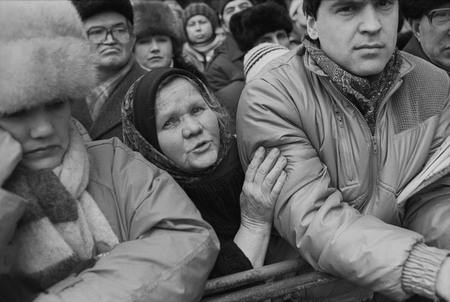'Mikhail Gorbachev. Perestroika' is an exhibition project dedicated to social, cultural and political changes in the Soviet Union between 1986 and 1991. This exhibition organized by the Gorbachev Foundation to mark the 80th birthday of the first USSR President is an attempt to present perestroika as a time of dialogue and communication, when politics intersects with underground art, unofficial culture is legalised, people discover previously banned literature and the increasing activity of the new press, when the words o Viktor Tsoi's song become the byword of the era: 'Changes! We are waiting for changes!' — although nobody quite understood what changes to expect. Visitors will see more than 300 images taken by the best photographers (including Dmitri Baltermants, Yuri Rost, Pavel Kassin, Anthony Svo, Valery Shchekoldin, Andrei Bezukladnikov, Sergei Zinoviev, Mark Steinbock and Alexander Dzhus). These photographs record events that were decisive for the USSR and the whole world — the fall of the Berlin Wall, the unification of Germany, the withdrawal of Soviet forces from Afghanistan, Andrei Sakharov's return from exile, the August 1991 Putsch and the meeting with US President Ronald Reagan in 1987. The exhibition also features outstanding art by glasnost generation — works by Boris Orlov, Sergei and Vladimir Mironenko, Yuri Avvakumov and Andrei Filippov. In 1990 Pavel Lungin directed his first film,'Taxi Blues', receiving Best Director Prize at the Cannes Film Festival the same year. This film shot in the final years of perestroika not only sums up the entire period in a highly original manner, but also in many ways anticipated the conditions in Russia during the 90s. In the perestroika years previously banned films by Alexander Askoldov, Alexander Sokurov and Sergei Selyanov were given a new lease of life. These works comprise the video section of the exhibition, together with excerpts from television programmes and documentary films. The Gorbachev Foundation's unique collection of photographs will acquaint visitors with the private life of Mikhail Sergeyevich and help us chart the evolution of a man who transformed the country that was his own flesh and blood, and was himself transformed. Despite some contradictory evaluations Mikhail Gorbachev's actions led to total reform of the USSR, which is today hard to overestimate. During the perestroika period the Iron Curtain fell, market economy and business structures were established, censorship disintegrated and the population finally had an opportunity to discover the big wide world for themselves. Although we should not forget the disaster at the Chernobyl Nuclear Power Plant, the events of Black January and the complex economic situation that led to foodstuffs disappearing from the shops and empty shelves. Over several years of intense socio-political activity in Russia people's attitudes changed radically, especially among those working in the arts. After the declaration of glasnost art developed at a furious pace as the artists perceived the unprecedented freedom of self-expression. In the photographs of Alexander Borodulin, Sergei Rumyantsev and Andrei Bezukladnikov the visitor can see artists who emerged from the underground scene at that time — Ilya Kabakov, Erik Bulatov, Boris Orlov, Konstantin Zvezdochetov, Georgy Ostretsov, Dmitri Prigov and Pyotr Mamonov, from the cradle of the thunderous'new wave' of art emanating from Furmanny Lane in those years. Captured in the photographs of Sergei Borisov are the rock groups Aquarium and Zvuki Mu, Viktor Tsoi and Zhanna Aguzarova — undisputed trendsetters and heroes of the new music and fashion. A large section of the exhibition consists of portraits, photographic documentation of art happenings and the first attempts at fashion photography. An understanding of the importance of personal, particular and individual values finally replaced the dictate of featureless masses. For this reason a significant part of the exhibition is occupied by photographs taken all over Russia of ordinary people — the younger generation, children, pensioners and families. They stand in endless queues and sign up to buy meat (Pavel Kassin), wave banners at political demonstrations (Valery Shchekoldin, Alexander Abaza, Viktor Akhlomov), or just get on with everyday life in a troubling period full of hopes, forebodings and disappointments (Sergei Zinoviev, Yuri Rost, Igor Mukhin). 'Mikhail Gorbachev. Perestroika' is a first attempt, possibly still incomplete, to assemble diverse aspects of Russian life in one exhibition with the aid of those photographs, artworks, films and music that best reflect the spirit of their time. This was an epoch when myths were destroyed, but perestroika itself became one of the most important Soviet myths that the present generation must now decipher. The International Foundation for Socio-Economic and Political Studies (Gorbachev Foundation) was established in December 1991 by Mikhail Gorbachev, President of the USSR.
The Gorbachev Foundation has been active since January 1992. President of the Foundation: Mikhail Gorbachev Vice-President: Irina Gorbacheva-Virganskaya Legal entities and individuals from any country may take part in the Foundation's activities in a voluntary capacity. The Gorbachev Foundation closely cooperates with leading universities, foundations, international organisations, government bodies and non-governmental associations in various countries all over the world. Among the participants in its research projects are respected scholars and researchers from Russia, other CIS states, the United States, Canada, Japan, Germany, France, Spain, Italy, South Korea, and other countries.






















